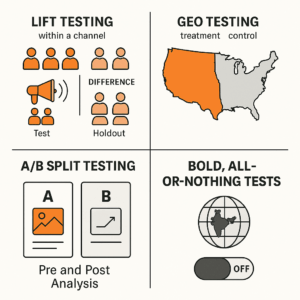For early-stage marketers, developing a testing mindset is crucial for unlocking growth. I’ve witnessed this play out repeatedly with the high growth businesses I have worked with at Playbook Media and Meta before that. This often involves addressing understandable—yet ultimately limiting—fears within your finance team.
The Finance Team Hurdle: Fear of the Unknown
I often find our clients are so focused on returns from every single dollar, they’re simply afraid to test new things. It’s not always the marketer’s call, though, it’s often the CEO, or CFO, or the broader financial team’s influence. These financial teams are frequently scared of spending money towards performance branding, or towards new solutions. They want to measure everything against data in the CRM, attribution tool, or god-forbid Google Analytics, but this almost always leads to incorrect conclusions at scale.
To help them to see that current analytics solutions are not accurate, marketing teams much implement tests to prove investment in difficult to measure channels drive a return. Given their bias toward hard data, finance teams want a guarantee of performance return on a test, which, honestly, you can’t give, because it’s a test.
We saw this with a test we did for one of our clients. It was originally designed as a $200k test to achieve statistical significance, but because of financial restrictions it was reduced multiple times and eventually only was allowed to spend a ¼ of the original budget. Predictably, we saw inconclusive results, because we essentially “limped into the test,” as I like to say. If you’re not willing to truly lean into it, you waste time and money, and you don’t learn what you need to move your business forward.
For a testing mindset to work, marketing and management teams need to have PATIENCE. Although this isn’t always easy there are some tactics you can leverage.
- Mid Flight Checkins: regularly assess the delivery metrics to ensure your test is meeting your benchmark KPI, for example impressions, traffic, leads or revenue. If a test is clearly not measuring up to your expectations, kill it.
- No-Lose Framing: given the difficulty to get additional budget approved, a good 2 prong test is to cut budget from channels or tactics where returns are questionable and reallocate to new channels or upper funnel tactics. If revenue doesn’t drop, that is a win in itself, especially if you increase reach to an expanded audience.
- Use MMM (or other data) to Inform Tests: using a media mix model is a great way to inform which tactics to test. The data can help marketing to hypothesize where to reallocate budgets for better returns and management teams are more likely to buy in given it’s a data backed strategy.
Understanding finance’s hesitation often stems from a fear of “zero return.” Address “wasting budget” concerns by explaining that well-designed tests provide critical learning, even if immediate revenue isn’t apparent.
Funding Real Tests: Go Big, or Go Home

I’ve observed companies that take a testing mindset in marketing are far more successful than those who try to design amazing campaigns and are unwilling to test new things. Think about SpaceX. Every time one of their rockets blows up, they don’t call it a failure. Instead, it’s celebrated as more data for them to use to improve future launches.
As a digital marketer, you need to adopt a “fail forward” mentality like SpaceX, viewing every test, even those that don’t immediately pan out, as valuable data for future growth and optimization.
Put Your Money Where Finance’s Mouth Is
If you have limited funds for testing in a year, I think it’s better to go big on a couple of tests than do a whole bunch of little ones, which could end up being inconclusive. When I was at Meta, we used to preach this framework: set aside 20% of the budget for testing. The reality was, not one of my clients actually did that.
But that’s the way it should be. You should be taking a fifth of your budget and putting it towards testing, and if you’re going to do that, you should put it against tests that are actually going to move the needle. This means funding big tests, relative to that budget, and using most of it on one test at a time. So, if you have a $500k monthly budget, for example, you should be running a $300k test over three months, not just one smaller $100k test per month—or worse three $30k tests per month.
Allocate your testing budget wisely, focusing on substantial tests that promise significant impact rather than numerous small, inconclusive ones.

Types of Marketing Tests to Implement Now
Here are a few tests that you can start using for your campaigns:
- Lift Testing (within a channel): This is where you set up a holdout audience within a specific advertising channel. You then compare the conversions of the holdout group (who didn’t see your ads) against a test group (who did). The difference between these two groups shows your incremental customer acquisition cost or returns from the ads you spent. Channels like Meta and TikTok allow for this randomization fairly well.
- Geo Testing: This concept is similar to lift testing, but it uses geographic areas. You run ad spend in some states or cities (the “treatment” group) and not others (the “control” group). By looking at the differences in new customers while holding other factors equal, you can measure your overall return. There are tools to help split up similar geos for this.
- A/B Split Testing: Many platforms have this built in, allowing you to run two different creatives or elements against each other to definitively understand which one worked better. This is useful for optimizing specific components within a campaign.
- Pre and Post Analysis: This is a more “quick and dirty” method where you compare your conversions before a new initiative to your conversions after it. While not as scientifically rigorous as true test and control groups due to potential outside factors like seasonality, it can give you fast, early indicators.
- Bold, All-or-Nothing Tests: Consider truly bold tests, like Meta CMO Andrew Schultz, who temporarily turned off all ads in a specific region (India) to gauge the total impact on conversions. While not for the faint of heart, such an approach can offer undeniable proof of your marketing’s overall contribution.
I recommend dedicating a substantial portion, ideally 20%, of your marketing budget to significant, impactful experiments like the ones above. This approach is more effective than dispersing smaller amounts across numerous inconclusive tests.
The Clear Takeaway
Successful marketing is about continuous learning and adaptation. Embracing a testing mindset, even in the face of internal budget pressures, isn’t just a nice-to-have; it’s the fundamental way to find scalable success and ensure your marketing efforts continue to drive your business forward.
If you liked reading this article, you can catch more insights from me by subscribing to our weekly newsletter here.
Or if you need help implementing the tests I mentioned above, contact our team here.




